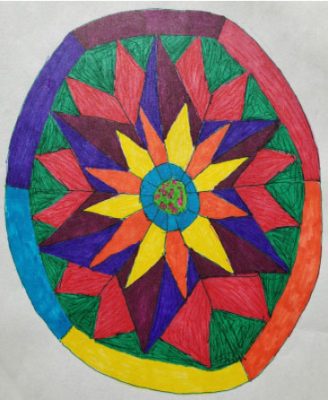Impermanence, vulnerability and slowing down: Lessons from meditation

During the very first session of the EPIC series, our group created visual representations of our teaching philosophies. After I began drawing, I saw that I was making a mandala. In some spiritual traditions, mandalas may be used as an aid for meditation, and through drawing my own mandala I realized that teaching and meditation are closely connected for me. I share some of my connections below.
Nothing Is Permanent
Everything changes. Even if I teach the same class every year, the class is never the same. The students change, the content is tweaked, the classroom discussions are different, even the syllabus changes. The teaching and learning environment can change — for example, a face-to-face setting can turn into an online environment. Sometimes the changes happen gradually and slowly. Other times, they happen rapidly with very little preparation time. Impermanence reinforces the idea that having “control” of any situation in my life is an illusion. I can never prevent the waves of change from coming, but I can learn to surf those waves the best I can. Also, remembering that nothing is permanent gives me freedom to be in the present moment with my students, and to appreciate each moment in the classroom, even if the moment may be uncomfortable. Because the present moment is all I have.
Slowing Down
Meditation helps me slow down my thoughts and be present with silence. Stillness. Pause. As a result, I have noticed that the nature of my classroom conversations has shifted. I welcome more wait time. When I ask a question or bring up an idea, I pause, breathe and literally count to 10 in my head (sometimes longer) to allow for thinking time. In those moments of silence, some interesting connections and questions can surface. I’ve also noticed that having more time for pause in my classroom has helped me be a more present and active listener. Discussions now take longer than planned but they tend to have more depth. Sometimes less is more.
It’s OK to be Vulnerable
So many insecurities arise in me during my meditation and teaching practices. Am I doing this right? Is it normal to have these thoughts and feelings swirling around? These insecurities make me feel vulnerable, but I am beginning to see value in allowing myself to be vulnerable. To try something brand new in the classroom without knowing how it will go, like abandoning “traditional” exams for group exams, asking my students to co-construct a course syllabus with me, etc. Additionally, early in my teaching career, I also felt shame if a student asked me a question that I did not know the answer to. But, there is so much uncertainty in the world (nothing is permanent!), that it’s OK for me to say “I don’t know.” It’s OK to think, “I have no idea how this is going to go, but I’m willing to give it a try.” In fact, these moments of trying new things and accepting uncertainty, these moments of vulnerability, have led me to increased curiosity and growth. And these moments of vulnerability have allowed me to learn from my students in ways I hadn’t thought possible.
This tip is the fifth in a series of Teaching Tips from UAF instructors working together to build innovative courses in the EPIC program.

Wendy Martelle
Assistant Professor
Wendy Martelle is an assistant professor of applied linguistics and ESL in UAF’s English department and linguistics program. She holds a BA in International Studies and Russian from Dickinson College, an MA in Russian Philology from Moscow State University, and an MA and PhD in Applied Linguistics/Second Language Acquisition from the University of Pittsburgh

Thank you for your thoughts and realizations. I have been teaching American Sign Language (ASL) at UAF/CTC for over 20 years. The radical shift from face to face classroom to on line instruction for a language that requires 3-D representation, strong eye contact and physical proximity has been the biggest challenge I have faced. I do not feel that I have succeeded when I compare what we are doing now to what I have done in the past, but being open to “not knowing” has been a huge part of my ability to continue. I used the analogy of the Titanic. At spring break, it felt like it was all sinking and my job was to put as many students in lifeboats as possible and carry on. From 20 students, we have 17 who have succeeded in staying afloat. I am actually looking forward to a time when the 17 of us can get together physically and celebrate. In the meantime – BREATHE.
These are very useful tips, Wendy. Thanks for writing this!